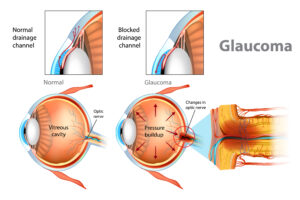Do you or someone you love have glaucoma? It’s understandable if you’re nervous, but glaucoma doesn’t have to mean the end of your vision.
Glaucoma is the name given to a collection of eye conditions that cause damage to the optic nerve. The optic nerve is a bundle of millions of nerve fibers that carry messages to your brain and allow you to see.
Since the optic nerve connects the eye to the brain, your brain can’t receive any necessary information about what you’re seeing when it becomes damaged.
Damage to the optic nerve causes spots in your peripheral vision and, eventually, tunnel vision. The more damage to the optic nerve, the narrower the tunnel and your vision.
While glaucoma is widely recognized as a health risk for older patients and is the leading cause of blindness in adults over 60, it often goes undiagnosed. For many patients, the eye condition has few, if any, symptoms in its early stages.
But once it does, the damage to the optic nerve is irreversible, and so is any vision loss that glaucoma causes. Because of this, glaucoma is often called the Silent Thief of Sight.
There are several different kinds of glaucoma, but some are far more common than others. Keep reading to learn more about glaucoma and how to treat the most common types.
Open-Angle Glaucoma

Open-angle glaucoma is by far the most common form of glaucoma. Like most other forms of glaucoma, it involves a build-up of intraocular pressure (IOP).
Increases in intraocular pressure occur when the fluid that flows through your eye to keep it healthy, called the aqueous humor, doesn’t drain properly. The pressure puts strain on the optic nerve, damaging it over time.
The “angle” in open-angle glaucoma is the primary drainage angle. The primary drainage is a channel made between the iris and cornea.
When you have open-angle glaucoma, this channel isn’t blocked off. Instead, the trabecular meshwork is blocked off.
The trabecular meshwork is the system of semi-permeable tissue surrounding the eye that fluid drains through. Usually, in open-angle glaucoma, pressure builds very slowly over a long period.
The only way to spot open-angle glaucoma in the early stages is to have your eyes examined regularly. By measuring your IOP, your eye doctor at Omaha Eye may even be able to recommend treatment for high IOP before you suffer any damage to your optic nerve.
But left undiagnosed and untreated, open-angle glaucoma can lead to total vision loss.
Angle-Closure Glaucoma
Angle-closure glaucoma is a rarer form of glaucoma. It occurs when the primary drainage angle becomes blocked off.

The primary drainage angle gets blocked when the iris bulges, closing the channel between it and the cornea. Unlike open-angle glaucoma, this often happens very quickly.
Acute angle-closure glaucoma happens immediately, causing several noticeable symptoms, including eye pain, headache, blurred vision, nausea, and vomiting. If you experience these symptoms, seek emergency treatment immediately.
Intraocular pressure can build up fast, causing irreversible vision damage. If treated promptly, this pressure can be relieved, usually through surgery that removes a small part of your iris. If you do not receive prompt treatment, you may end up with permanent vision loss.
Other Kinds of Glaucoma
The two most common forms of glaucoma are open-angle and angle closure. Of those two, open-angle glaucoma is far more common. Open-angle glaucoma makes up 80-90% of all glaucoma cases in the US.
Close to 10% of all other cases are angle-closure glaucoma. However, a small percentage of glaucoma cases are one of the rarer forms of glaucoma. These rarer forms include:
Normal-Tension Glaucoma
Normal tension glaucoma occurs when you don’t have high IOP, but the optic nerve is still damaged.
Secondary Glaucoma
Secondary glaucoma occurs when an injury, other condition, or certain medications cause optic nerve damage. Traumatic glaucoma is another kind of glaucoma that can result from an injury, either immediately or years later.
Pigmentary Glaucoma
Pigmentary glaucoma occurs when tiny particles from the back of the iris that gives it its pigment break off and get trapped in your eye’s drainage channels, raising your IOP.
Exfoliative Glaucoma
Exfoliative glaucoma is similar to pigmentary, but the particles in question flake off your lens.
Neovascular Glaucoma
Neovascular glaucoma occurs when blood vessels in your eye grow abnormally and block off drainage channels.
Uveitic Glaucoma
Uveitic glaucoma occurs when inflamed structures in the eye block off drainage channels.
Congenital Glaucoma
Congenital glaucoma occurs in babies born with eyes without fully formed drainage structures, developing glaucoma soon after birth.
Treating Glaucoma
There is no cure for glaucoma, but you can manage it to prevent further optic nerve damage. Treatment, therefore, is aimed at lowering IOP.
Most treatments are for patients with open-angle glaucoma, but they may be effective for any glaucoma caused by high IOP. These treatments include:
Medication

Your eye doctor may prescribe you eye drops or oral medication to lower IOP. To prevent further optic nerve damage, you must take this medication consistently and often indefinitely.
It may also be prescribed if you have high IOP but haven’t yet developed glaucoma.
Surgery
There are many kinds of surgery used to treat glaucoma. One of the most common ones is a trabeculectomy.
A trabeculectomy surgically creates a pathway through your eye through which fluid can drain. Other procedures may involve implanting a small drainage device.
One tiny drainage device, the iStent, can even be inserted during cataract surgery.
Laser Treatment
Laser therapies for glaucoma may benefit patients with mild or moderate glaucoma. They tend to be less invasive than traditional surgery, and you may be able to have many performed by your eye doctor in-office.

If you’re diagnosed with glaucoma, your eye doctor will devise a treatment plan catered to you and the severity of your glaucoma. It may involve a combination of these treatment options.
Do you have glaucoma and need to know all your options? Schedule an appointment at Omaha Eye in Omaha, NE, to find out how our team of experts can help you!





